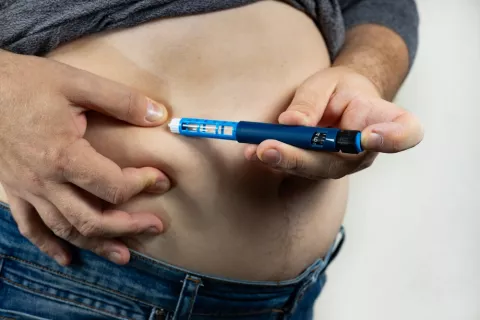More and more people dream of losing extra kilos. And if it can be done effectively and in a short time, the better. Ozempic, a drug initially indicated for the treatment of type 2 diabetes, has recently emerged as the most powerful solution for all those people who urgently needed to lose weight. But everything that shines so bright sometimes hides a hidden side. In this case, in the form of an aged face as an unwanted effect. The rapid weight loss provided by semaglutide – its active ingredient – can affect the elasticity of the skin and cause body sagging, which is usually more noticeable in areas such as the face, and especially in the cheeks, where fat contributes significantly to the youthful appearance.
Hence that famous phrase attributed to Catherine Deneuve that says that from a certain age you have to choose between your face and your ass; That is to say, if you want to reduce the volume of some areas, such as the butt, you must keep in mind that eliminating extra kilos can take a toll on your face and that you should not resort to medication for this without consulting a doctor.
- What is the Ozempic face effect and how does it affect the appearance of the face?
- Signs that characterize the Face of Ozempic
- How can you prevent Ozempic face
What is the Ozempic face effect and how does it affect the appearance of the face?
Precisely, the Ozempic face or Ozempic face is a term that has gained popularity in recent months to describe this aesthetic side effect associated with the use of Ozempic. This term refers to the loss of facial fat that some people experience as a result of the rapid weight loss that occurs with the use of this medication.
Ozempic is given as an injection once a week and is part of new medications to treat obesity called glucagon-like peptide-1 (GLP-1) receptor agonists. These drugs act on two natural hormones that help control blood sugar levels and accelerate the feeling of satiety.
The digestive system breaks down the carbohydrates present in food into simple sugars that travel through the bloodstream and GLP-1 agonists induce the release of insulin in the pancreas, which helps reduce blood sugar levels and transport it to the cells. to be used as a source of energy. For this reason, these types of drugs were initially developed to treat diabetes, but after it was proven that they also act in the brain to reduce hunger and delay gastric emptying, making the person feel full for longer, they began to be used. to lose weight.
However, when someone loses weight suddenly, not only body fat is eliminated, but also facial fat, which can make the facial skin look thinner or sagging and give the appearance of an aged or haggard face. This adverse effect, together with the support of celebrities for injectable medications used to lose weight, has led to the spread on social networks such as TikTok of the term ‘Ozempic face’, a condition that, although not dangerous to health , can make those affected complex.
Signs that characterize the Face of Ozempic
Specifically, the rapid and significant loss of facial fat that people experience when using the slimming drug Ozempic can trigger aesthetic changes, the most characteristic of this facial skeletonization being:
- More visible wrinkles.
- Sunken eyes.
- Accused flaccidity.
- Alterations in the volume of the cheeks, lips and chin.
- Dewlap.
- Sagging of facial structures.
- Premature aging of the face and tired appearance.
These changes in the face may be less noticeable if the weight loss after using semaglutide occurs gradually and some measures are adopted, such as those explained below.

How can you prevent Ozempic face
Avoiding Ozempic face or minimizing its effects is possible through a combination of aesthetic care, lifestyle adjustments and preventive strategies. We offer you some recommendations to try to mitigate the loss of facial volume when following a weight loss regimen with Ozempic or any other similar medication:
- Gradual weight loss and under medical supervision: Rapid weight loss is one of the main factors contributing to the Ozempic face. Talking to your doctor about a slow, gradual weight loss plan can minimize facial fat loss and prevent your skin from being drastically affected.
- Maintain adequate hydration: staying well hydrated and drinking enough water is essential for the skin to retain its structure, elasticity and firmness and have a healthy appearance.
- Using skin care products: Using moisturizers and anti-aging creams that promote collagen and elastin production can be helpful in keeping skin firmer. Ingredients like retinol, peptides, and hyaluronic acid can help improve skin elasticity.
- Apply facial sunscreen: It is also advisable to use sunscreen daily to protect the skin from sun damage that can accelerate aging.
- Balanced nutrition: Eating a diet rich in protein, antioxidants, vitamins and minerals can help improve skin health. In particular, collagen-rich foods or collagen supplements can help maintain skin structure.
- Facial exercise: Facial exercise can be beneficial in toning facial muscles and improving blood circulation, which can help reduce sagging.
- Cosmetic treatments: such as dermal filler injections to restore lost volume or radiofrequency or ultrasound treatments to improve skin firmness. Microneedling and laser treatments that promote collagen production can also be effective options.
- Consultation with a dermatologist or aesthetic medicine specialist: If facial volume loss is concerning, a consultation with an expert allows a personalized plan to be developed that includes specific treatments or products tailored to individual needs to address Ozempic’s face.















